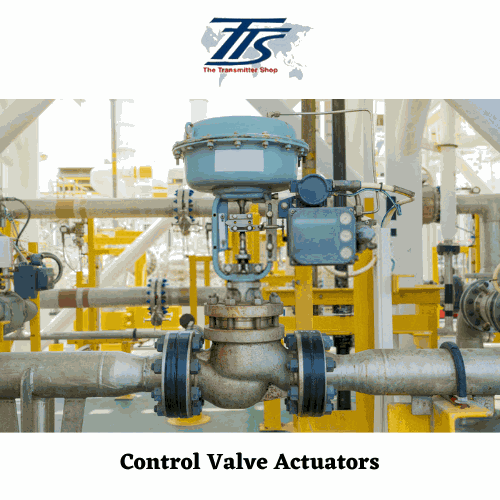Control Valve Actuators: Different Types and Failure Modes Discussed
Brian Craig
June 03, 2021
The control valve actuators are the triggering units in control valves. These actuators are responsible for generating the motive force needed to operate the valves. The actuators can be operated using different types of energy provision systems such as hydraulic, pneumatic, manual, electrical, etc. Therefore, there are multiple types of valve actuators. Different types of actuators offer different operational parameters and performance efficiencies. Also, different types of these actuators feature different design specifications and scope for failure during applications. While using the actuators, it is essential to understand the types, and failure modes. That is why this post introduces valve actuators, different types, and failure modes for them.

Control Valve Actuator
The control valve actuators are small units that are designed to actuate the movable parts of a valve such as plugs, balls, and vanes. The actuator receives commands from the control system to generate the desired amount of motive force. As the motive force is applied, the performance of the valve actuator terminates and the valve starts operating.
Different Types of Control Valve Actuators
The following are the three main types of valve actuators.
1. Pneumatic Actuators: This valve actuator is pneumatically operated. This type of actuator features a pair of diaphragm and springs that are linked to each other. As the signal is received from a control system, the diaphragm and spring react to the force causing movement of the valve stem.
There are two types of pneumatic actuators available.
- Direct pneumatic actuators
- Reverse pneumatic actuators
2. Hydraulic Actuators: These actuators share several similarities with pneumatic actuators. Hydraulic actuators feature a piston-rod arrangement of diaphragm and spring. The pistons are filled with hydraulic fluid. As the signal comes from a control system, the rod moves forward or reverse, based on which the actuator force increases or reduces. The valve stem is actuated by hydraulic force.
3. Electrical Actuators: The electric actuators feature a motor-operated trigger as the actuating element. These actuators can generate linear or rotary action of the valve. These actuators are commonly used for ON/OFF operations however, they can be used for continuous processing if integrated with a feedback loop. This way, these actuators can be automated.
Note: These main types of valve actuators can be merged together for enhanced performance. The hybrid types of valve actuators like electro-hydraulic, pneumatic piston controlled actuator, etc are available.
The actuators can be designed according to different failure modes. Let us discuss the same.
Failure Modes of Actuators
Commonly, the failure modes of actuators are achieved as either fail open or fail close. The following designs are adopted to achieve one of the failure modes. For the design to achieve a specific failure mode, the following two combinations of the valve body and actuator combinations are used.
1.Air to Close Valve (ACV): In this type of combination, a reverse acting actuator is connected to the reverse body or vice versa. This combination fails the open valve if operated in open condition.
2. Air to Open Valve (ATO): In this type of combination, a reverse actuator is connected to the direct valve body. This combination fails to operate if the close circuit conditions.
Since the type of actuator makes a high impact on the performance of the control valve, the actuator should be of verified quality. That is why you should source valves and actuators from the trusted suppliers like The Transmitter Shop. The company holds 50 years of experience in supplying high-quality transmitters, control valves and actuators, and related process control equipment
Related Posts
- Causes & Solutions of Annoying Noise from Control Valves
- Understanding Industrial Control Valves and their Types
- All Important Questions on Control Valves Answered
- 3 Common Control Valve Maintenance Practices
- Know Everything About the Benefits, Applications, Types, and Automation of Control Valves
- How to Select the Right Control Valve for Your Process?
- Calibration of Control Valve Positioner: The Process Discussed
- Control Valve Actuators: Different Types and Failure Modes Discussed
- Calibration Guide for Fisher 3582 Pneumatic Positioner
- How to Do the Periodical Inspection and Maintenance of the Control Valve?
- Temperature Control Valve – Definition and Working Principle
- Reasons to Choose Remanufactured Instrumentation and Control Valves
- Single Acting vs. Double Acting Positioners: Pros and Cons
- Complete Hydrogen Gas Safety and Measurement Solutions
- Steam Boiler Drum Level Measurement A Comparison of Control System Technologies
- Furnace Flame Sensor Faults Everything You Need to Know for Safe Operation
- Comparison between Multi Valve Manifolds Block Valves and Bleed Valves
- Pneumatic Pressure Controllers: A Safe Choice for Hazardous Areas
- Furnace Flame Sensor Faults Everything You Need to Know for Safe Operation
- Pneumatic Pressure Controllers: A Safe Choice for Hazardous Areas
- How Can Greenhouse Gas Emissions Be Reduced?
- A Practical Guide to Vacuum Measurement and Operation
- Understanding Electrochemical Detection: Principles, Techniques and Environmental Application
QUICK ENQUIRY







